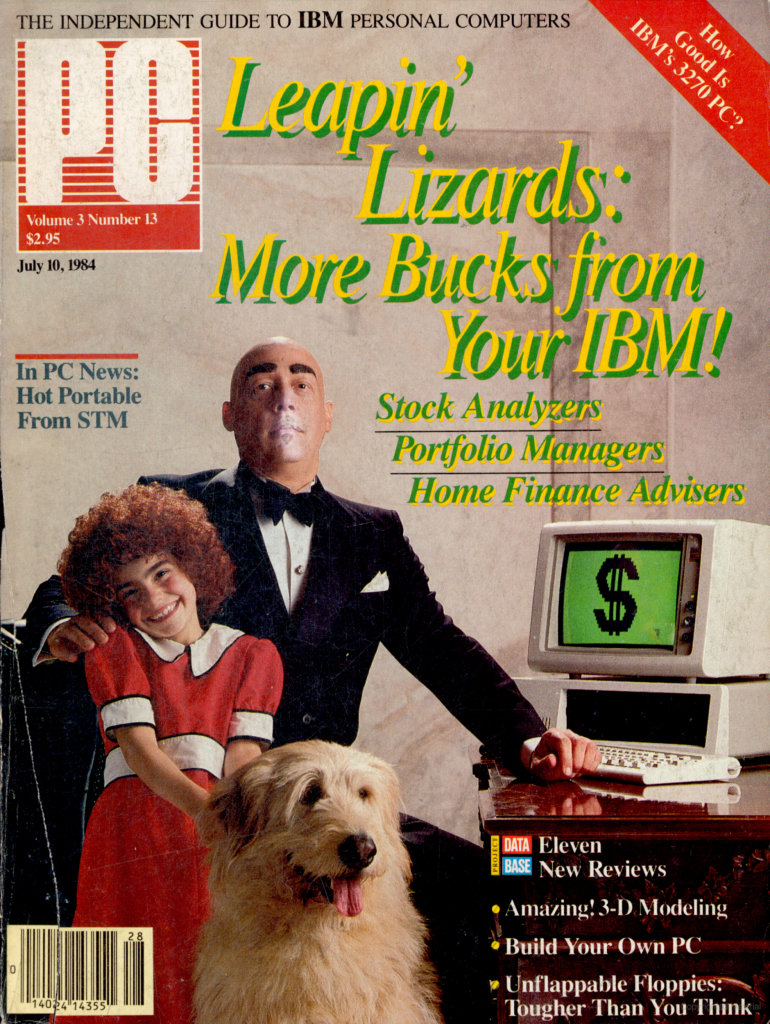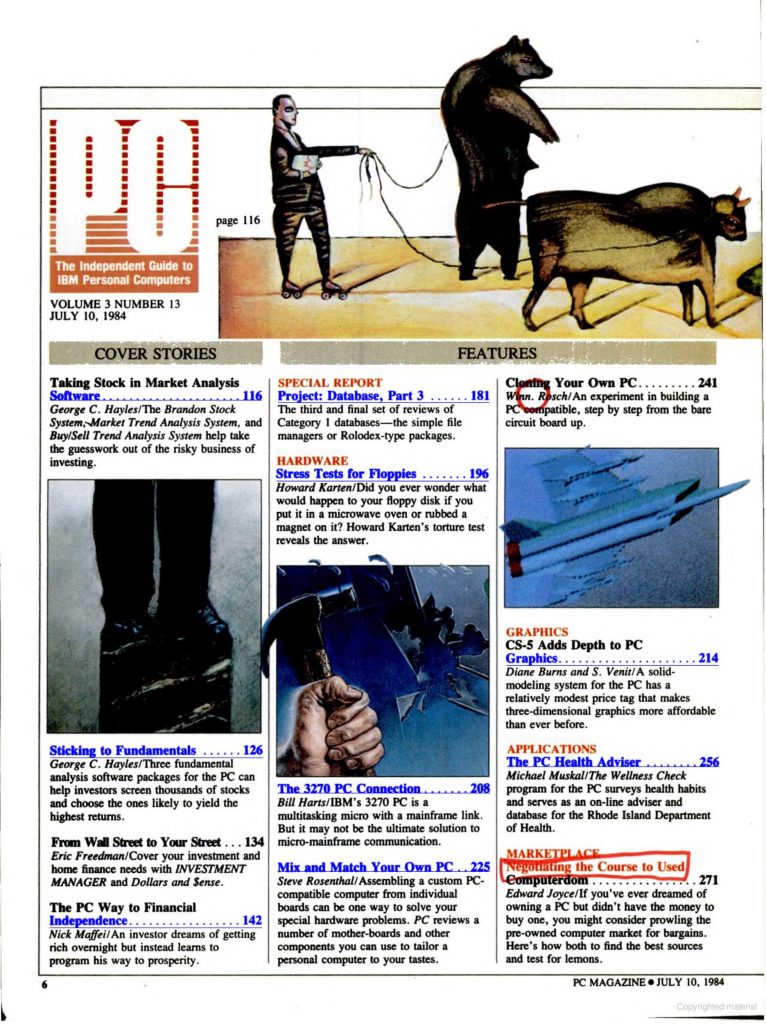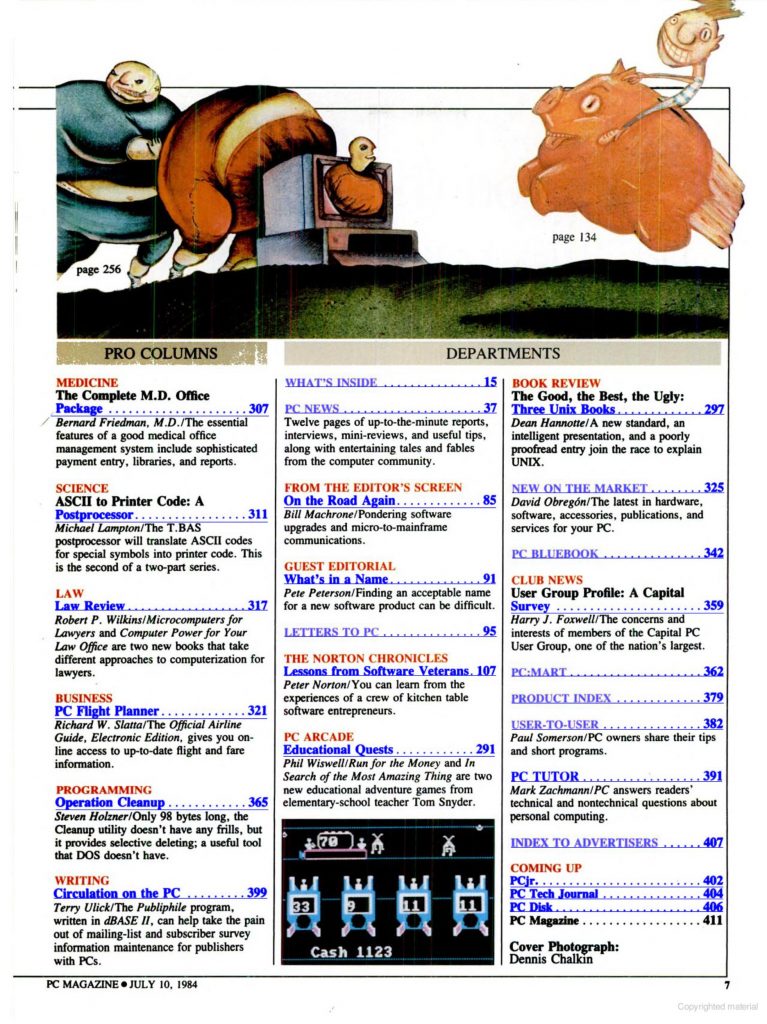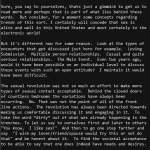Source: PC Magazine – July 10th, 1984
PC Magazine was one of the most popular computer magazines in the 1980s and 1990s. At that time, I’m not sure if PC World or PC Magazine had the bigger circulation numbers. There were plenty of other magazines for other (non-PC compatible) systems but even this early, it was pretty clear that the PC was winning. If nothing else, that can be seen my the size of the magazines. The July 10, 1984 issue of PC Magazine weighs in at over 400 pages and includes:
Cover Stories
- Taking Stock in Market Analysis Software – A look at three software packages meant for analyzing the stock market. These include The Brandon Stock System, Market Trend Analysis System, and Buy/Sell Trend Analysis. Generally, these required a subscription service to get the needed data (via disk or via modem).
- Sticking to Fundamentals – A guide to analyzing the fundamentals of a company (income statement and balance sheet statistics) and the software to help you do it.
- From Wall Street to Your Street – A look at Investment Manager, software designed to help you manage your investment portfolio.
- The PC Way to Financial Independence – Using your PC to manage your finances. This article goes over using spreadsheets, writing your own software and more.
Features
- Project: Database, Part 3 – The third and final part of a review of available database software. The concentration is on simple databases. Software reviewed here includes Super Database Management, PFS:File and PFS:Report, Query!, Beast Data Manager, Data Design, and Rank and File
- Stress Tests for Floppies – A series of tests to determine how fragile (or durable) floppy disks really are.
- The 3270 PC Connection – The IBM 3270 is an expanded version of the PC-XT with rudimentary multitasking capabilities designed to interface with a mainframe.
- Mix and Match Your Own PC – A guide to building your own PC compatible computer. It starts with a look at the relatively few PC motherboards available at the time, the Display Telecommunication’s MegaBoard, Electro Design’s IMP-12, Micromint’s MPX-16 or Super Computer’s Super PC.
- Cloning Your Own PC – This takes the above concept, which is similar to building a PC today, a step further. This article is an introduction to building your own PC Clone starting from a bare circuit board.
- CS-5 Adds Depth to PC Graphics – A detailed review of Cubicomp’s CS-5 Solid Modeling System. This is 3D CAD Modeling software with prices starting at $10,000 but that was a bargain compared to standalone CAD systems at the time.
- The PC Health Advisor – Review of software designed to analyze health risks to you (not your PC). It includes a survey and database.
- Negotiating the Course to Used Computerdom – A guide to shopping for a used computer. Includes advice on where to look, testing, negotiating and more.
Pro Columns
- The Complete M.D. Office Package – A doctor discusses what features should be included in any medical office management system. These include payment entry, libraries, reports, and more.
- ASCII to Printer Code: A Postprocessor – A type-in BASIC program that will translate ASCII codes for specialized symbols from your word processor into a language your printer can understand.
- Law Review – A review of two books written for lawyers who are planning to computerize their practice. These books are Microcomputers for Lawyers by J. Stewart Schneider and Charles E. Bown and Computer Power for Your Law Office by Daniel Remer.
- PC Flight Planner – A guide to using the on-line version of the Official Airline Guide, Electronic Edition. Anybody can plan a flight today on the internet but doing so with online information in 1984 was much more novel.
- Operation Cleanup – A type-in program designed to let you selectively delete files (e.g. you can select all BASic files and it will prompt you one by one whether you want to delete them or not).
- Circulation of the PC – A review of Publiphile, software designed to assist you in managing your publication’s mailing lists and readership data.
Departments
- PC News – STM Portable PC released for $3449, PFS software released for IBM PCjr, upcoming UNIX software, new PC compatibles from ITT and Otrona, new integrated software package (Electric Desk) for the PCjr, new networking technology from IBM, Phoenix develops IBM compatible BIOS, new KB515 keyboard from Key Tronic, and much more.
- On the Road Again – When to create new software version and the future of micro-to-mainframe communications.
- What’s in a Name – The art of naming software.
- Letters to PC – Letters from readers about Proportional Spacing on WordStar (book), using ProKey with wordSTar, bugs in Microsoft Word 1.0, a potential bug in KnowledgeMan (DBMS), WordVision, and more.
- Lessons from Software Veterans – Peter Norton writes about lessons to be learned in the realm of small software entrepreneurs.
- Educational Quest – A look at two new educational games: Run for the Money from Scarborough Systems and In Search of the Most amazing Thing from Spinnaker Software.
- The Good, the Best, the Ugly: Three Unix Books – Reviews of The UNIX Programming Environment (the Best), The UNIX operating System (the Good), and The UNIX Book (the Ugly).
- New on the Market – A brief look at new hardware and software including new expansion boards from Cygnus (parallel and serial ports), Taxan monochrome monitors, StoreageMaster 500 Series 18MB and 30MB hard drives (for $2495 and $3390 respectively), the Colby KEY-2 Keyboard, S/COM 3400 Streamer (tape backup system), CERTIFIED Accounting System, Forbidden Quest (adventure game), dMS-III (DBMS), RamDisk II (for emulating a disk drive in RAM), and much more.
- User Group Profile: A Capital Survey – The results of a survey done by Capital PC USer Group. This was a large PC users group with 2,500 members.
- User-To-User – A simple and free way to create a telephone directory, creating a menu for basic DOS commands via batch files, and more.
- PC Tutor – Questions answered about changing sector size of a disk, BASICA vs. BASIC, using FORMAT with large amounts of memory (> 480K) in early PC-DOS versions, restoring a hard drive, and more.
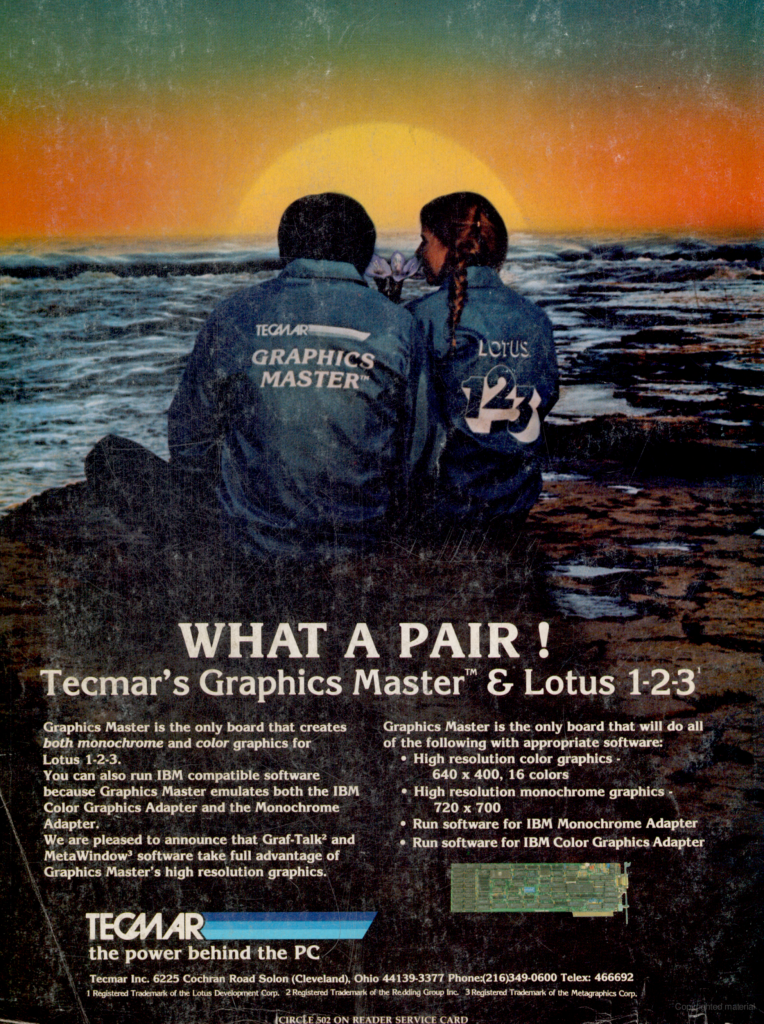
…and more!
